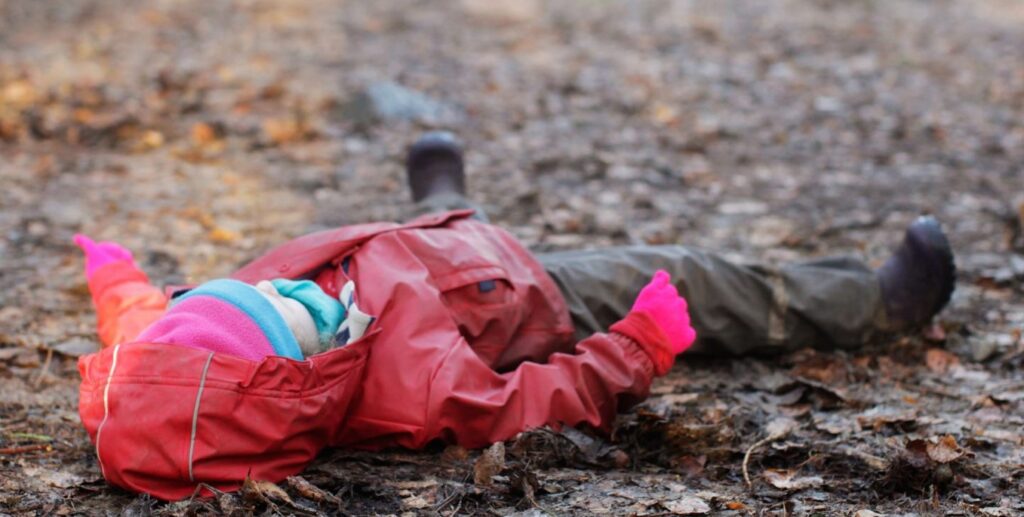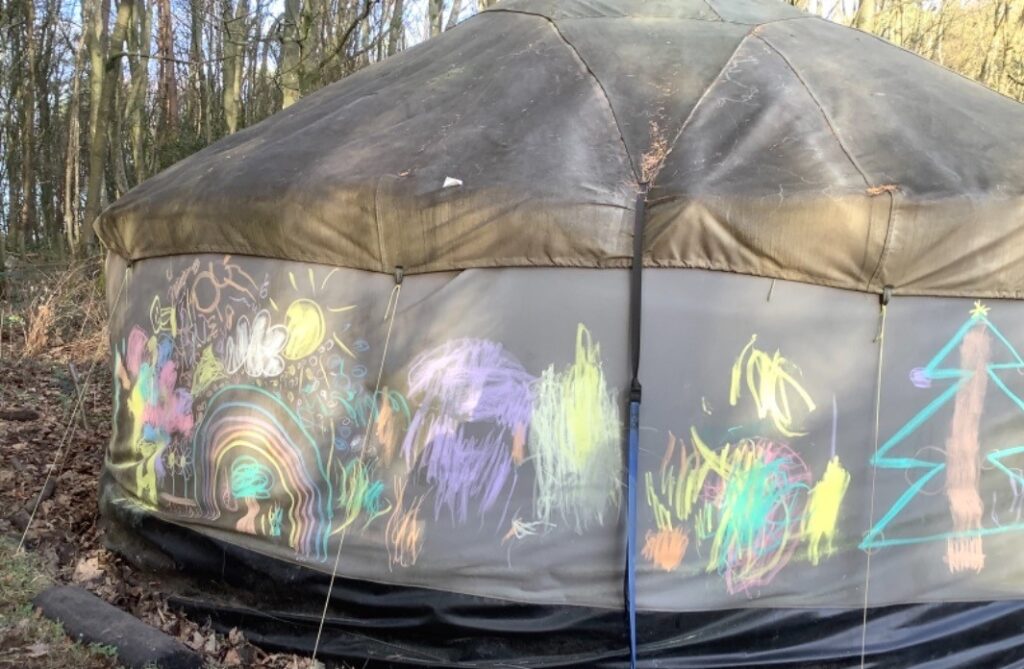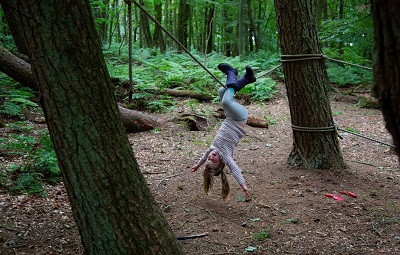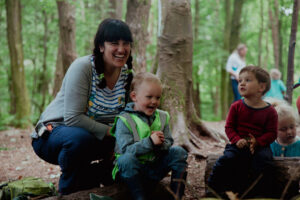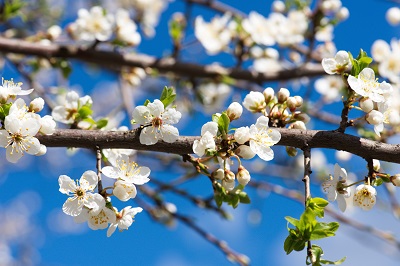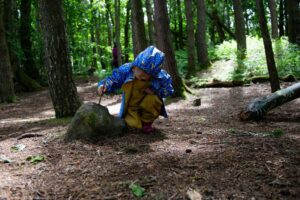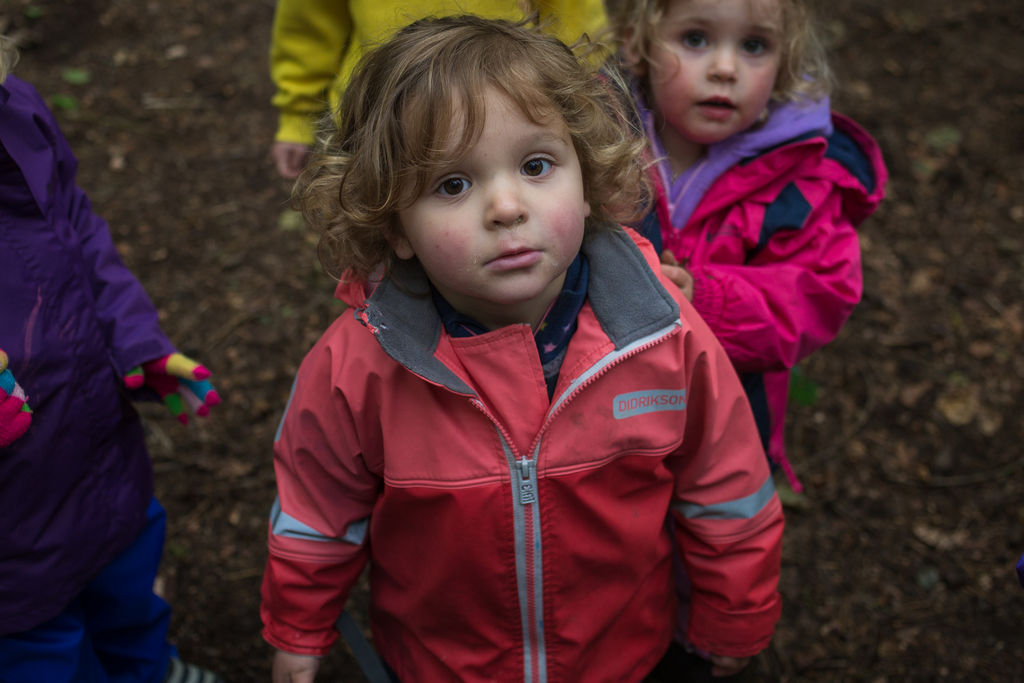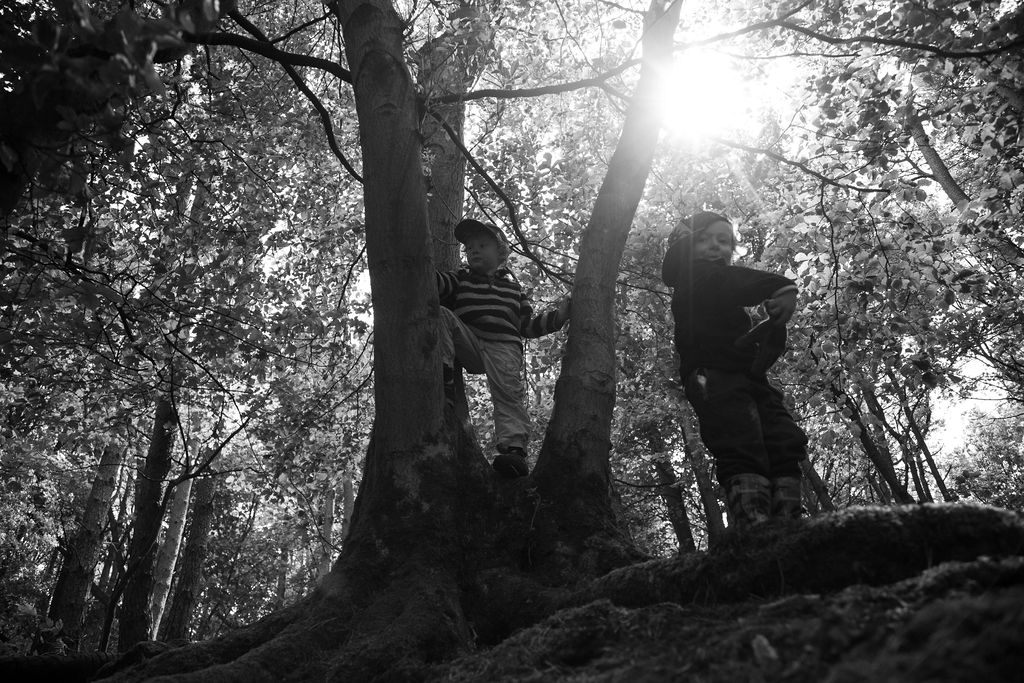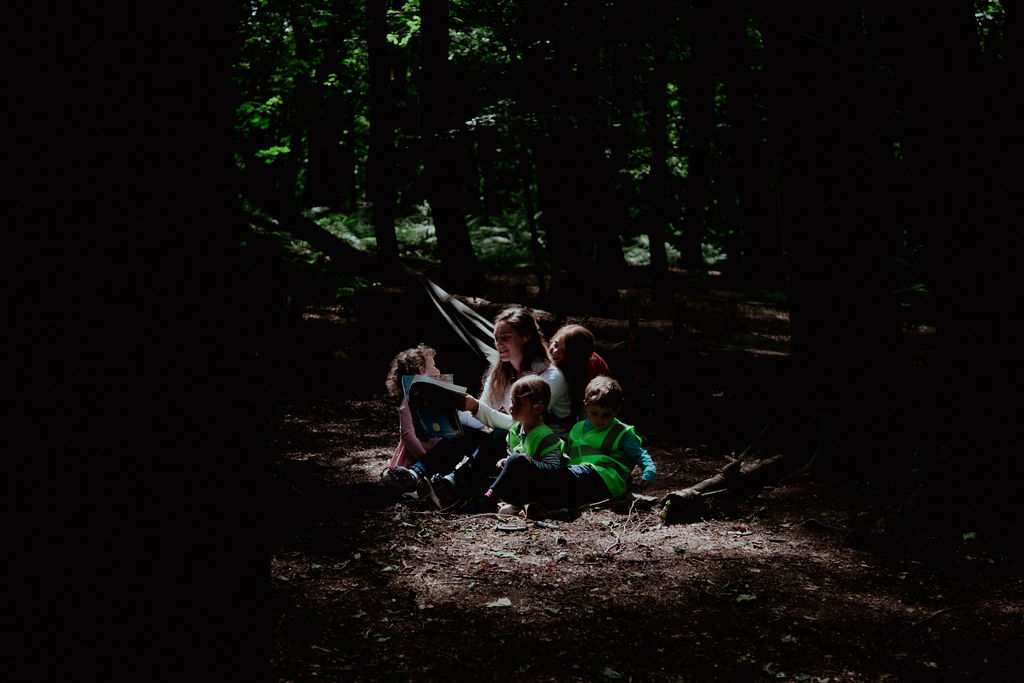Written by Emma Goodfellow with input and contributions from Mazz Brown, Louise Durrant, Clare Davis and Vicky Hobba.
Families often wonder how best to educate their child, and as they reach preschool age, we often hear questions such as, “How do children adapt from playing outdoors all day, to sitting at a desk and needing to learn numbers and letters when they don’t learn them at the nursery?”
Firstly, we find that almost all children settle at school with no problems, and there is often quiet relief that the very active and vocal child that parents and carers worry about funnels their energy into exciting new learning.
Secondly, we see the children engaging with numeracy and literacy daily at the nursery. This can be through their own play such as comparing stick lengths for building den structures, singing while playing, exploring our number resources or mark making on paper, the ground or trees. It can also be practitioner driven by the songs we sing for transitions and activities during the day, special focus on children with delayed speech and language or the many oral and read stories we integrate into our day. Free play in the woodland environment is perfect for the development of whole body coordination, gross and fine motor skills, all of which are important and age appropriate foundations for the numeracy and literacy skills which will be learned in school. These are just a few examples, and we record notable ones for supporting the children’s development.
As a parent who has recently been through this transition twice from The Secret Garden to primary school, I have some insight into the experience. Naturally, every child and family are different in their needs when transitioning into their school years, and it would be good to highlight that there isn’t a single straightforward answer for how a child (or parent/Carer!) should be supported through the changes they`ll experience, or what kind of education would suit your child.
What are the options?
When looking at all the options, whether that is diving straight into P1, deferring a younger child, starting after P1, flexi-schooling or home educating it may feel difficult to decide what to do. The good news is you can review how your child is doing over time and make changes to suit them and you.
Some children are ready to make the transition straight into P1 and thrive in the school environment. For others, it takes some time for them to settle in. For families who don’t have a choice to defer, flexi school or home educate, schools are well placed to support a younger child or one who might require some extra support. There is a growing movement to extend play based learning into P1-2 and sometimes higher up in the school. Some schools have great links with an attached nursery, sharing resources and play with the younger children in the nursery class to soften the transition.
Deferral
Deferring a younger child who then would spend a further year at the nursery, can give a child time to mature emotionally and physically before starting school, we are happy to offer advice. If the child is eligible for deferral (between a mid-August and end of February birthday), this is funded in the same way that the other nursery years are (i.e. dependent on any blended setting and hours used). Some families whose child are not eligible for deferral choose to delay their schooling by a year. They would not be applicable for any funded nursery hours, but where it is an option to be privately funded, children can attend the Secret Garden (provided there is a space available) up to their 7th birthday.
Flexi-schooling (either at home or becoming a Secret Garden Buzzard)
You may choose to do something other than the standard 5-day school week, and different families have a whole host of reasons for doing so. For example, a friend flexi-schools her children one day a week as they are bi-lingual, and it means they can focus on German books and resources during that time.
Flexi- schooling is a broad category and there are ways to tailor your options. Some families choose to flexi-school one day at home, or the Secret Garden, alongside 4 days of school. Some families even do one of each with 3 days at school. Others may home educate for a few years then begin school, or the other way round…
Flexi schooling is at the discretion of the school and different schools do take different approaches. We do find that Fife is progressive in this area compared to other Local Authorities. We advise you to speak to the school to explore this option. A lot of schools around us are very supportive of the choices families make.
I flexi-schooled my children one day a week for P1 and P2, each for different reasons. My youngest wanted to start school at 4 and to ensure he had enough rest time midweek, we flexi-schooled on a Wednesday, until he was able to move to a full 5 days. My eldest benefits mentally and physically from time in nature so being able to enjoy time outside once a week, really helped them both. I needed to stop due to our home life but hope to begin again when the situation allows.
Some children benefit from bridging the transition from the Secret Garden to school by staying one or two days a week with us for a “Buzzard” year (provided there are spaces available). We enjoy observing how their role in the woods changes as they mature, and they build on their learning, friendships and experiences.
Home education
Home education may be right for you and can be suited to those who thrive with a path more tailored to suit their interests and pace. Parents often know by this point whether home education might be best for their family or you may need to change from mainstream education due to necessity. Home education can feel isolating for some parents and building a good supportive group around yourself can help. (We note some helpful resources further down.)
Sometimes children will need a new plan, (occasionally several throughout their education) and listening to their needs and working with those around them is so important to ensure that they thrive. You know your child, and you know it is impossible to move through life making the best or ideal decision every time.
Reflecting on how things are going, and keeping the communication lines open with all parties is the best way to ensure your child’s wellbeing and education are fully supported.
Preparing for school after forest nursery
Our experience shows that the grounding the children have at the Secret Garden prepares them well for life. Their rich experiences and child-led play in the woods help them to develop social skills, a curiosity to learn, resilience and self-esteem. With these key things blossoming, children are well placed to learn numbers, letters and facts later.
Our Peripatetic teacher often remarks that children at the Secret Garden have more highly developed fine motor skills, this includes the ability to hold pencils and other tools. Gross and fine motor skills are developed so well during these play-filled years with us in the woods.
We have had lovely feedback from a local teacher in a Primary school that receives Secret Garden graduates most years, saying
“I always find that the children that come from the Secret Garden are more inquisitive and show more of an interest in learning something new. I find that they are more resilient than other children whether that is due to the outdoor setting, coping with weather, having to be more creative or imaginative but they are also more willing to give things a go and be less defeated if things go wrong. They are also a little more confident and louder!!”
How we can support children through the transition
We can see children being aware of the upcoming changes during their last term or two. Some worry, some are excited, many push the boundaries and almost all engage in a lot of play around the subject to process their feelings.
We support the children by listening to them, engaging with their play when invited, answering their questions, and providing warm limits and boundaries when needed. As we near this time, we help children feel their sense of being in that transition phase, as one of the “bigger ones”, for example, they often bring in notebooks in the last term to write or draw in and we often give them some extra responsibilities so they get to step up and lead more in the group.
It is helpful to practise reflecting on feelings and to practise some independence skills such as changing their own clothes, zipping jackets, putting on shoes, packing their bag, going to the toilet and washing hands. We support these skills with your child throughout their time at nursery. As their first day approaches try to get your child used to a routine as close to the one they will have when starting school. This allows the changes to be more gradual and less likely to be overwhelming on their first day.
Schools usually offer settling in sessions, with different schools offering these at different times. We encourage the class teachers to visit the children in the woods so the teachers get to know the children a little, and the children can feel safer on their first day with a face they are more familiar with.
We ask families to fill out “All about me” forms for us to send to the schools. A local teacher gave the following feedback about the benefits of these visits and communication.
“I really enjoy the “All about me” information as it is concise and straightforward and gives you all the information you need to draw on for those initial interactions and relationship building…. I think it is very important to visit the site as part of the transition process as the format is so different from a typical council or indoor private nursery setting. Being on site has allowed me to see the levels of independence and creativity the children are capable of. It has also allowed me to be better able to put in place provisions in our school setting, that build upon this independent learning style and creativity, to make the transition a bit more straightforward for these children.”
Where to get information?
Your child’s key worker and the practitioners who work with your child regularly are ideally placed to talk with you about your options. Our Care Manager, Assistant Care Manager and Administrative Manager are also experienced at supporting families through these times. Former Secret Garden parents are very happy to support on our closed Secret Gardeners Facebook group and other parents and families around you may have good advice too, or just be able to listen as you go through the decision- making process.
There are many website-based resources such as the Parent Club website, along with Parenting across Scotland and there are many pages advocating for a delayed or slower transition from nursery to school such as Give them time and Upstart.
For home education and Flexi schooling, there are many groups and resources to help with this and some local places to start with are Wilder Ways and Horizon groups which are run by Sustainable Community Initiatives, Fife Flexi Fridays support and Fife Home Educators. The Scottish Government also offers home education guidance along with many websites including The Scottish Home Education Forum and Fife Council.
To note: We are aware that this blog is not inclusive of children who require a higher level of additional support to go through their education. Local Schools for Children with Additional Support Needs such as Kilmaron school in Cupar and Falkland House School may be able to support families with their individual needs. Fife Council website lists other options across the wider Fife area, Education Scotland and the Scottish Government also outline guidance and support options. The Enquire website has resources and factsheets on school placements and planning for starting school to support families with children with support needs. Kindred Scotland are an advocacy organisation for parents of children with complex needs. I have used them and found them helpful.


